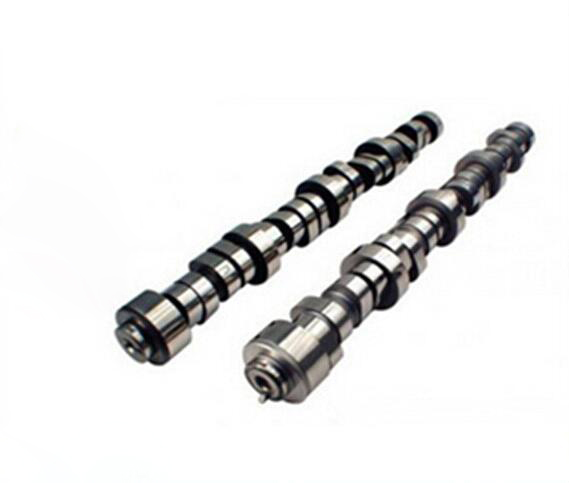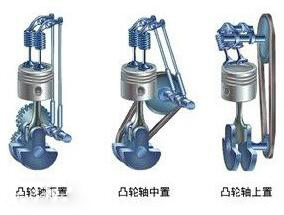Camshaft Introduction

The camshaft is a component of a piston engine. Its function is to control the opening and closing of the valve. Although the speed of the camshaft in a four-stroke engine is half that of the crankshaft (in a two-stroke engine, the speed of the camshaft is the same as that of the crankshaft), its speed is usually still very high, and it needs to bear a lot of torque. Therefore, the design has high requirements for the strength and support of the camshaft, which is generally made of high-quality alloy steel or alloy steel. Because the law of valve movement is related to the power and working characteristics of the engine, camshaft design plays a very important role in the design process of the engine.
Camshaft working conditions and materials
The camshaft bears periodic impact load. The contact stress between the cam and the tappet is very large, and the relative sliding speed is also very high, so the cam working surface is seriously worn. In view of this situation, the camshaft journal and cam working surface should have high dimensional accuracy, small surface roughness and sufficient rigidity, as well as high wear resistance and good lubrication.
Camshaft is usually forged from high-quality carbon steel or alloy steel, and can also be cast from alloy cast iron or nodular cast iron. The working surfaces of journal and cam are polished after heat treatment.
Structure

The main body of the camshaft is a cylindrical rod whose length is approximately the same as that of the cylinder bank. Several cams are sleeved on it to drive the valve. The camshaft is supported in the camshaft bearing hole through the camshaft journal, so the number of camshaft shaft diameter is an important factor affecting the camshaft support stiffness. If the camshaft stiffness is insufficient, bending deformation will occur during operation, thus affecting the valve timing.
The side of the cam is egg-shaped. It is designed to ensure sufficient intake and exhaust of the cylinder. In addition, in consideration of the durability and smoothness of the engine, the valve should not have excessive impact due to the acceleration and deceleration process during the opening and closing actions, otherwise it will cause serious wear of the valve, increased noise or other serious consequences. Therefore, the cam is directly related to the power, torque output and running stability of the engine.
Camshaft position
There are three types of camshaft positions: lower, middle and upper. The camshaft of the lower valve train is located in the crankcase, the camshaft of the middle valve train is located in the upper part of the engine body, and the camshaft of the upper valve train is located on the cylinder head.
At present, the engines of most mass production vehicles are equipped with overhead camshafts. The main advantages of overhead camshaft structure are less moving parts, short transmission chain, and large stiffness of the whole mechanism, which makes the camshaft closer to the valve, reducing the waste of round trip kinetic energy caused by the large distance between the camshaft and the valve. The engine with overhead camshaft has higher speed and better operation stability due to its fast valve opening and closing action.
Transmission
Common transmission modes between camshaft and crankshaft include gear transmission, chain transmission and toothed belt transmission. The transmission between the lower camshaft and the central camshaft and the crankshaft is mainly driven by the cylindrical timing gear. Generally, only one pair of gears is required from the crankshaft to the camshaft. If the diameter of the transmission gear is too large, another intermediate idler gear can be added. In order to smooth mesh and reduce working noise, most timing gears are helical gears.
O acionamento por corrente é comum entre o eixo de comando de válvulas e o virabrequim, mas sua confiabilidade e durabilidade não são tão boas quanto o acionamento por engrenagem. A correia dentada é amplamente usada para substituir a corrente de transmissão em motores de alta velocidade, mas a transmissão por corrente ainda é usada em alguns motores de alta potência. A correia dentada tem características de baixo ruído, operação confiável e baixo custo. Para DOHC, a árvore de cames de escape é geralmente acionada pelo virabrequim através da correia ou corrente de distribuição, a árvore de cames de entrada é acionada pela árvore de cames de escape através da corrente de metal, ou ambas as árvores de cames de admissão e de escape são acionadas pelo virabrequim através da correia ou corrente.
Falta
As falhas comuns da árvore de cames incluem desgaste anormal, ruído anormal e fratura. O desgaste anormal geralmente ocorre antes do ruído anormal e da fratura.
(1) A árvore de cames está quase no fim do sistema de lubrificação do motor, por isso a condição de lubrificação não é optimista. Se a pressão de abastecimento de óleo da bomba de óleo for insuficiente ou a passagem do óleo lubrificante estiver bloqueada, o óleo lubrificante não pode alcançar o eixo de comando ou o torque de aperto dos parafusos de fixação da tampa do mancal é muito grande e o óleo lubrificante não pode entrar a folga da árvore de cames, a árvore de cames irá desgastar-se de forma anormal.
(2) O desgaste anormal da árvore de cames fará com que a folga entre a árvore de cames e o assento do rolamento aumente, e o deslocamento axial ocorrerá quando a árvore de cames se mover, resultando em ruído anormal. O desgaste anormal também fará com que a folga entre o came de acionamento e o tucho hidráulico aumente, e o came colidirá com o tucho hidráulico durante a montagem, resultando em ruído anormal.
(3) A árvore de cames às vezes quebra e outras falhas graves. As causas comuns são fratura do tucho hidráulico ou desgaste grave, lubrificação deficiente grave, má qualidade da árvore de cames e fratura da engrenagem de distribuição da árvore de cames.
(4) Em alguns casos, a falha da árvore de cames é causada por fatores humanos, especialmente quando a árvore de cames não é removida corretamente durante a manutenção do motor. Por exemplo, ao remover a tampa do rolamento da árvore de cames, use um martelo para bater com força ou use uma chave de fenda para retirá-la, ou instale a tampa do rolamento na posição errada, resultando na incompatibilidade entre a tampa do rolamento e o assento do rolamento, ou o torque de aperto dos parafusos de fixação da tampa do mancal é muito grande. Ao instalar a tampa do mancal, preste atenção à seta de direção e número de posição na superfície da tampa do mancal e aperte os parafusos de fixação da tampa do mancal com uma chave de torque estritamente de acordo com o torque especificado.





















